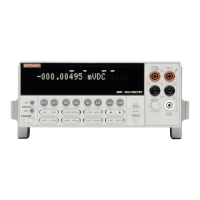Front Panel Operation
3-19
UNITS
This parameter selects the displayed units for AC voltage
measurements. You can program the ACV units parameter as
follows:
1. From the CONFIGURE ACV menu, select UNITS and
press ENTER. The following menu is displayed:
SET ACV DISP UNITS
VOLTS dB dBm
2. Highlight the desired units and press ENTER.
VOLTS: With volts selected as the units, AC voltage mea-
surements are expressed in volts.
dB: Expressing AC voltage in dB makes it possible to com-
press a large range of measurements into a much smaller
scope. The relationship between dB and voltage is defined by
the following equation:
where: V
IN
is the AC input signal.
V
REF
is the specified voltage reference level.
The instrument will read 0dB when the reference voltage
level is applied to the input. dB measurements are possible
on all ACV measurement types except positive peak spikes
and negative peak spikes, as these may be negative, and the
log of a negative number is not defined. Note that dB mea-
surements are specified only for the low frequency RMS
measurement type.
If a relative value is in effect when dB is selected, the value
is converted to dB. If a relative value is stored after dB units
are selected, the units of the relative value are dB.
To set the reference voltage level, perform the following
steps:
1. From the SET ACV DISP UNITS menu, select the dB
option. The following typical message is shown:
dB REF LEV:001.000 V
2. By using the cursor keys ( and ) and the RANGE
▲ and ▼ keys, you can enter the desired voltage refer-
ence level (0.001V to 750V).
3. Press ENTER to complete the change. If positive peak
spikes or negative peak spikes is the selected AC type,
the change is not allowed.
dBm: dBm is defined as decibels above or below a 1mW ref-
erence. With a user-programmable reference impedance, the
Model 2001 reads 0dBm when the voltage needed to dissi-
pate 1mW through the reference impedance is applied. The
relationship between dBm, a reference impedance, and the
voltage is defined by the following equation:
where: V
IN
is the AC input signal.
Z
REF
is the specified reference impedance.
NOTE
Do not confuse reference impedance with
input impedance. The input impedance of
the instrument is not modified by the dBm
parameter.
If a relative value is in effect when dBm is selected, the value
is converted to dBm. If a relative value is stored after dB
units are selected, the units of the relative value is dBm.
To set the reference impedance, perform the following steps:
1. From the SET ACV DISP UNITS menu, select the dBm
option. The following menu is shown:
SET dBm REFERENCE
50Ω 75Ω 93Ω 132Ω 300Ω 600Ω
2. Highlight the desired reference impedance and press
ENTER to complete the change. If positive peak spikes
or negative peak spikes is the selected AC type, the
change is not allowed.
dB/dBm notes:
1. dB and dBm units are not allowed with positive or neg-
ative peak spike measurements.
2. dB and dBm units are not allowed with an advanced fil-
ter.
3. With dB or dBm units selected, there is no bar graph on
zero-centered bar graph multiple display.
4. When units are changed from volts to dB or dBm with
A02 and greater firmware, all values less than zero that
depend on the new units are made equal to zero. This in-
cludes, for example, relative values and stored readings.
This avoids the overflow condition of a log of a negative
number.
dB
=
20
log
V
IN
V
REF
------------
dBm
=
10
log
V
IN
2
/
Z
REF
()
1mW
-----------------------------

